Menus
- Enforcer or sham?
- New mapping, different timing, additional intake pipes
- Kawasaki Z 1000 often and happily lifts the front wheel
- More freedom of movement is desirable
- Important changes
- PS data
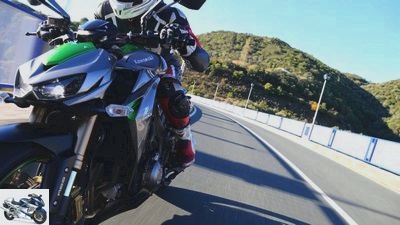
Kawasaki
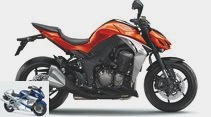
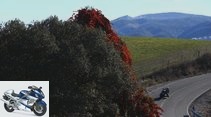
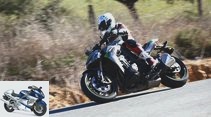
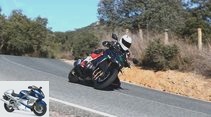
37 photos
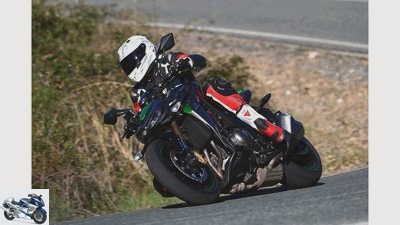
Kawasaki
1/37

Kawasaki
2/37
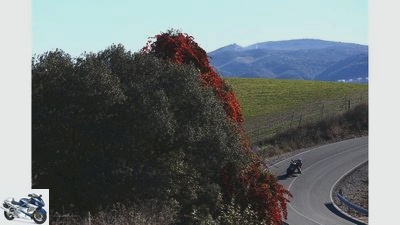
Kawasaki
3/37
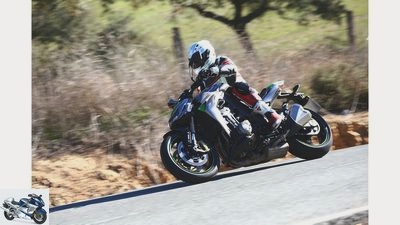
Kawasaki
4/37
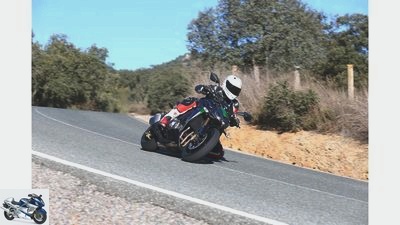
Kawasaki
5/37
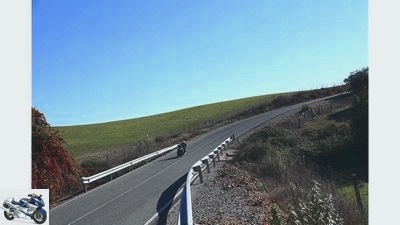
Kawasaki
6/37
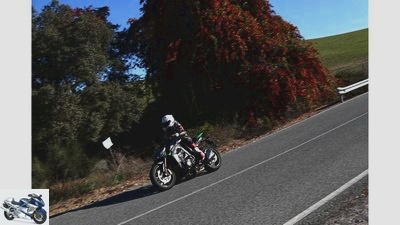
Kawasaki
7/37
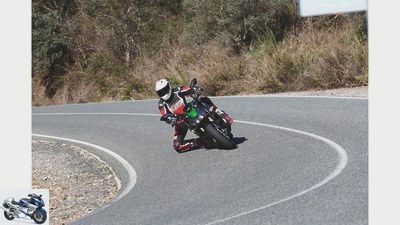
Kawasaki
8/37
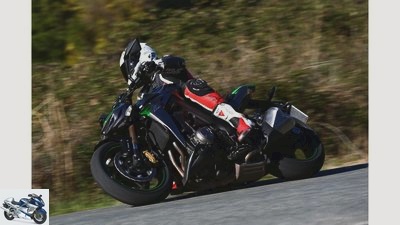
Kawasaki
9/37
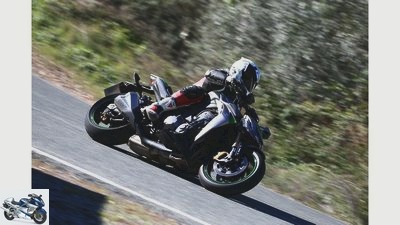
Kawasaki
10/37
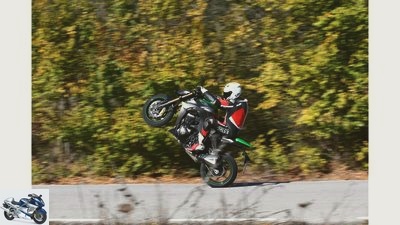
Kawasaki
11/37
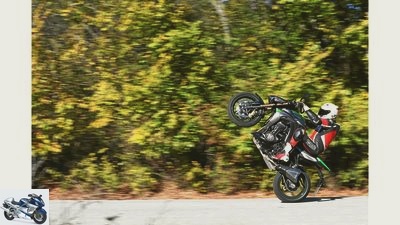
Kawasaki
12/37
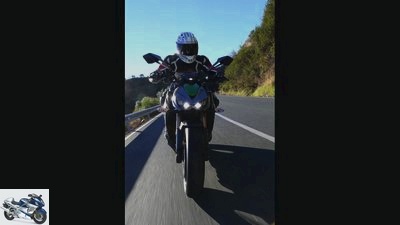
Kawasaki
13/37
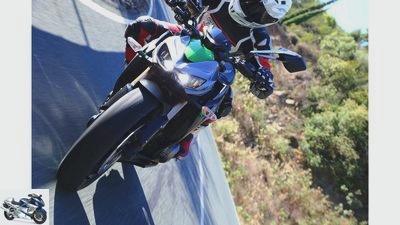
Kawasaki
14/37
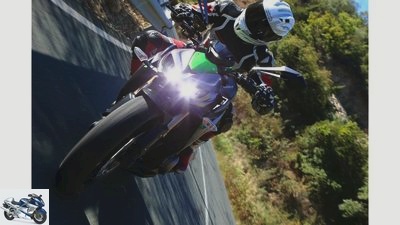
Kawasaki
15/37
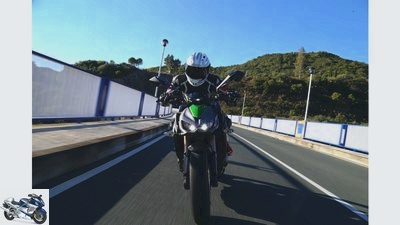
Kawasaki
16/37
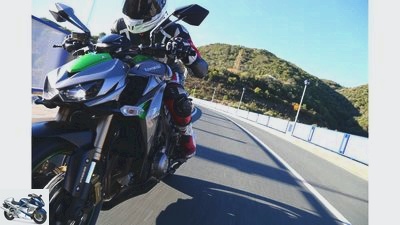
Kawasaki
17/37
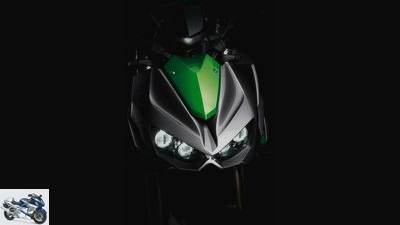
Kawasaki
18/37
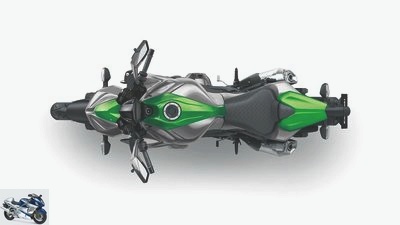
Kawasaki
19/37
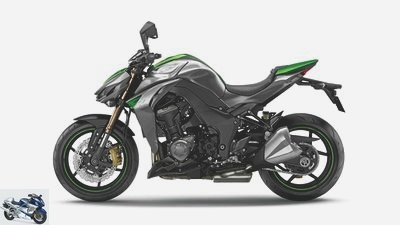
Kawasaki
20/37
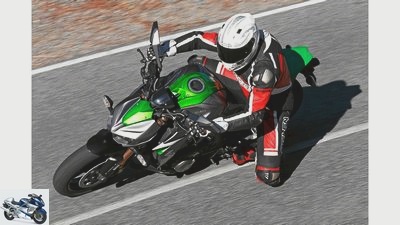
Kawasaki
21/37
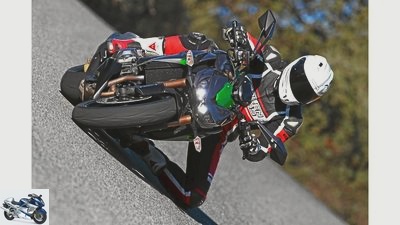
Kawasaki
22/37
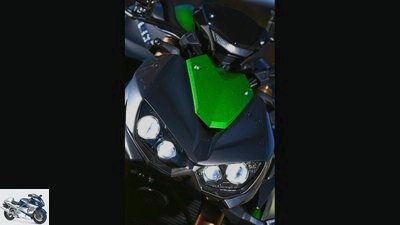
Kawasaki
23/37
Slim lamp mask, evil eye: thanks to reflectorless LED headlights, the unit is very slim.
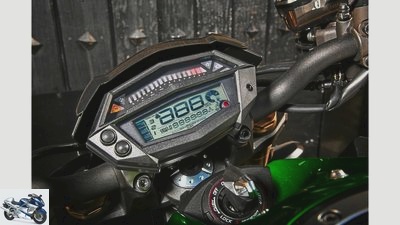
Kawasaki
24/37
New cockpit with subdivided tachometer: display up to 3000 rpm below, rest above.
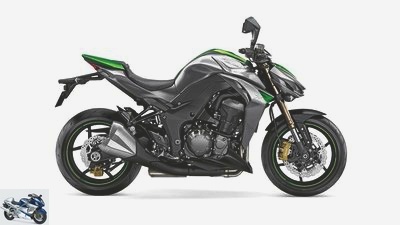
Kawasaki
25/37
Made class: beefy, aggressive and yet athletic shapes characterize the new Z 1000.
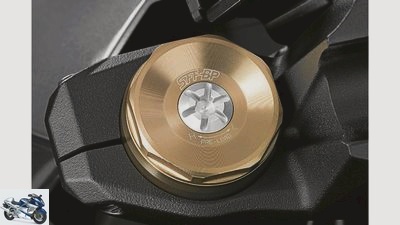
Kawasaki
26/37
SFF fork (Separate Function Fork): this is where the spring preload is located, …
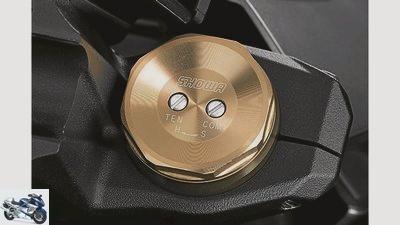
Kawasaki
27/37
… here the attenuation.

Kawasaki
28/37
The Z 1000 is finally a bike again that shows a clear edge instead of playing everybody’s darling.
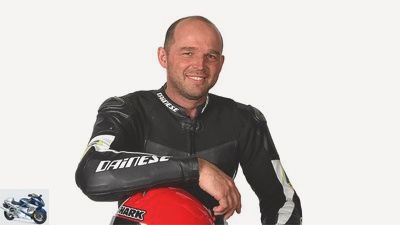
Kawasaki
29/37
Volkmar Jacob: Design, dynamics, pressure: the new Kawasaki Z 1000 turned out to be very extreme. It appeals primarily to experienced, sporty pilots and scares off less experienced pilots.
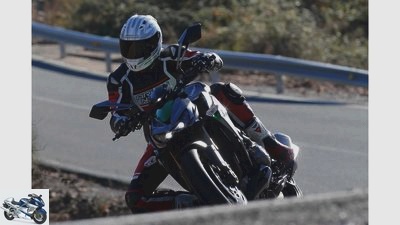
Kawasaki
30/37
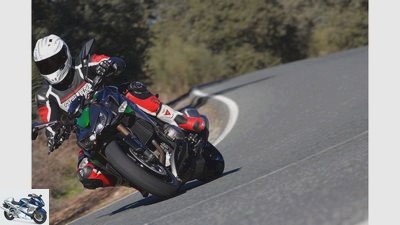
Kawasaki
31/37
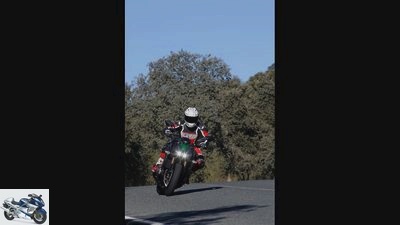
Kawasaki
32/37
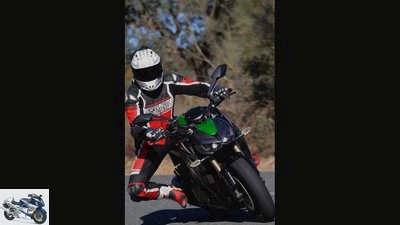
Kawasaki
33/37
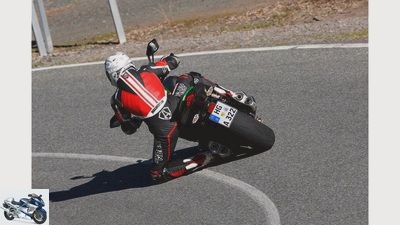
Kawasaki
34/37
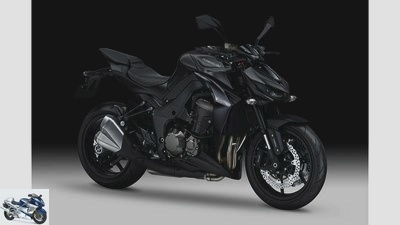
Kawasaki
35/37
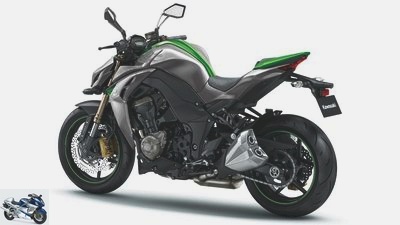
Kawasaki
36/37
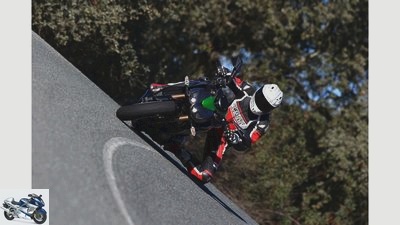
Kawasaki
37/37
Kawasaki Z 1000 in the HP driving report
Enforcer or sham?
Content of
The face of the new Kawasaki Z 1000 is reminiscent of nasty characters from Hollywood horror films. The design warns: Warning, dangerous! Enforcer or sham?
No other naked bike staged the combination of power and aggressiveness in such a captivating way as Kawasaki’s new edition of the Z series in 2003. The versions from 2007 and 2010 could not build on their predecessors in this regard. With the 2014 Kawasaki Z 1000 Kawasaki is now sending a really bad representative of the nude scene into the race and even adding a component to the design language: athletics.
Buy complete article
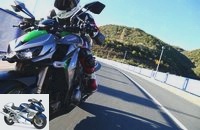
Kawasaki Z 1000 in the HP driving report
Enforcer or sham?
Kawasaki Z 1000 including the new headlight, which is very slim thanks to innovative LED technology. In addition, the lavishly dimensioned fork guards of the predecessor are missing and the trim parts are much more delicate. It looks really aggressive with the front-heavy optics and the beefy, tall tank. The now flowing transition from the driver’s seat to the front passenger seat also characterizes the exciting line of the Naked.
New mapping, different timing, additional intake pipes
The Japanese put as much effort into the engine as they did with the design. The Kawasaki Z 1000 is basically the quad of the old model with 1043 cubic meters. But for a better response and additional punch (142 instead of 138 hp) the Greens thoroughly modified the drive: new mapping, different timing, four intake funnels of the same length, reduction in pumping losses thanks to connection openings between the cylinders, leading directly from the front to the airbox additional intake pipes (“Cool Air”), larger, now oval interference pipes between the manifolds and a modified exhaust system. In addition, the Japanese increased the intake noise by inserting a new resonator into the air filter housing. Except for the airbox, its intake ducts and the mapping, the drive is structurally identical in the touring variant Z 1000 SX.
Even more violently than this, the naked storms away with the cock cocked. It is simply sensational how vigorously the Big Block grabs even on low tours and shoots the astonished pilot into orbit with his pedestal. Analogous to the speeds, the four-cylinder continues to power incessantly and only decreases slightly in the five-digit range. The secondary transmission, which is one tooth shorter, gives the load additional dynamics. The very direct throttle response fits in with the greedy characteristics, but it should catch particularly inexperienced contemporaries cold at first. “We deliberately tuned the engine so that we wanted to appeal to very sporty drivers with the Kawasaki Z 1000,” says project manager Yoichi Utsumi. What an announcement! Finally a bike that shows a clear edge instead of playing everybody’s darling.
Kawasaki Z 1000 often and happily lifts the front wheel
It fits into the radical picture that the Kawasaki Z 1000 often and happily lifts its front wheel. This inevitably happens in first gear if the pilot does not take off the accelerator in time. Even in the second, the tread increases without a clutch, a light pull on the handlebars is enough. This is particularly exciting at the exit of the bend, because there she powers out with the front wheel floating slightly above the ground – pure racing feeling! The catch: In attack mode there is a lot of restlessness in the front section, which means that the bike twitches the handlebars every now and then, especially on undulating surfaces, kickback not excluded! The Z 1000 does not have a steering damper. In addition, the very tight fork only absorbs coarse wrinkles to a limited extent, which also contributes to nervous behavior. The part equipped with SFF technology (“Separate Function Fork”) responds very well.
SFF means that the fork has a spring in both legs, but only one side can be pretensioned. In the other spar there are rebound and compression stages. Thanks to the Big Piston design, the damping can be easily adjusted on the upper fork plug. This combined design was first used in the current six-man ninja. The shock absorber of the Kawasaki Z 1000, on the other hand, has a conventional design. Its set-up was also quite tight, and the new deflection increased the compression progression. A slightly wider rebound stage tames the monoshock, which means that the part only looks a bit uncomfortable on very bumpy terrain.
More freedom of movement is desirable
Unusual and somewhat questionable when it comes to setup is that Kawasaki changed the geometry for the presentation in the direction of handiness. The technicians lowered the front by two millimeters and increased the spring preload at the rear. This means that the Kawasaki Z 1000 initially steers very easily and wonderfully neutral, but in the further course of the curve it blocks itself somewhat against an incline. The outdated rear tire size 190/50 (instead of 190/55) should also contribute to this. This can be remedied by shifting your weight and using slightly more force on the handlebars. Then the Super-Naked rushes wonderfully stable and precisely around corners. Unfortunately, due to lack of time, we could not find out how the thousands behave in the original trim. Only a detailed test can clarify this. It is already clear that very active drivers want a little more freedom of movement when cornering. The seat, which is comfortable but somewhat short, offers little space, especially towards the rear.
It is also clear that, unlike the SX, the naked one has no traction control. “We didn’t want to take any of the sportiness from the machine that we had previously acquired,” is the somewhat thin explanation from Japan. Of course, that’s also a question of cost, which Kawasaki frankly confirms. The manufacturer calls for 12,195 euros including ABS for the Kawasaki Z 1000. That seems appropriate, because after all, wild boys and girls get the most extreme stress of all time for it!
Important changes
drive
• more power (142 PS, 111 Nm)
• tamer tax times
• Changed intake ducts to the airbox
• four suction funnels of equal length
• new mapping of the motor control
• Connection openings between the cylinders
• larger, now oval interference tubes on the manifold
• revised exhaust
• longer sixth gear
• Final gear ratio shorter by one tooth
landing gear
• New Big Piston SFF fork
• revised shock absorber
• Wheels 1.5 kg lighter
• Monoblock calipers, new pads
• new ABS (Bosch)
• Dunlop tires D 214 “T”
miscellaneous
• completely new design
• reflectorless LED headlights
• sharper sitting position
• new handlebars
• new cockpit
• 17 liter tank (plus two liters)
PS data
Kawasaki Z 1000
Drive: Four-cylinder in-line engine, four valves / cylinder, 104.5 kW (142 PS) at 10,000 / min *, 111 Nm at 7300 / min *, 1043 cm3, bore / stroke: 77.0 / 56.0 mm, compression: 11 , 8: 1, ignition / injection system, 38 mm throttle valves, mechanically operated multi-plate oil bath clutch, six-speed gearbox, chain.
Landing gear: Light alloy central tube frame, steering head angle: 65.5 degrees, caster: 101 mm, wheelbase: 1435 mm, Ø fork inner tube: 41 mm, spring travel from / h .: 120/122 mm.
Wheels and brakes: Cast light alloy wheels, 6.00 x 17 / 3.50 x 17, front tires: 120/70 ZR 17, rear: 190/50 ZR 17, 310 mm double disc brake with four-piston fixed calipers at the front, 250 mm single disc with single-piston floating caliper at the rear , C-ABS.
Weight: (full tank) 221 kg * Tank capacity: 17 liters super.
Base price: 12,195 euros (plus ancillary costs) *.
* Manufacturer information
Kawasaki
PS tester Volkmar Jacob.
Design, dynamics, pressure: the new Kawasaki Z 1000 turned out to be very extreme. It appeals primarily to experienced, sporty pilots and scares off less experienced pilots. This is pure calculation, because Kawasaki wants to attract the buyers of the shrinking supersport segment. It could work out because the first “Zett” sold well 40 years ago. Reason: brutal image!
Related articles
-
BMW R 90 S, Kawasaki 900 Z1, Laverda 1000 3C Big Bikes
fact 30 pictures fact 1/30 Big-Bike classic from the 70s – pure fascination. Kawasaki 900 Z1, Laverda 1000 3C and BMW R 90 S from MOTORRAD Classic …
-
Air-cooled big bikes Kawasaki GPZ 1100 UT, Laverda RGS 1000 and Suzuki GSX 1100 EF
fact 48 pictures fact 1/48 The engines are the stars, they still exude charm and, in the case of GPZ, RGS and GSX, clearly inspire …
-
Kawasaki Versys 1000 SE driving report
Innovations 2019 Top Topic Kawasaki 22 pictures Kawasaki 1/22 colleague Jens Moller Toller aka MoTo drove the new Kawasaki Versys 1000 SE. In…
-
Kawasaki Versys 1000 driving report
Wright driving report: Kawasaki Versys 1000 (with video) Kawasaki’s all-rounder now with a large four-cylinder No half measures: For the Versys there is now the …
-
Kawasaki ZL 1000 and Yamaha Vmax
Stefan Wolf 38 Image archive 1/38 The “new” Vmax, in the range since 2008, also boasts superlatives in terms of performance, acceleration and …
-
Comparison Kawasaki Versys 1000, Kawasaki Z 1000 SX, Kaswasaki Z 1000
Jahn comparison test: Kawasaki Versys 1000, Kawasaki Z 1000 SX, Kawasaki Z 1000 The 1000s interpretations of Kawasaki Contents of Take the famous …
-
Kawasaki Z 1000 SX in the PS driving report
Kawasaki 35 pictures Kawasaki 1/35 Three years after the launch of the Z 1000 SX, Kawasaki gave the popular sports tourer a makeover. Kawasaki …
-
Gargolov Premiere: MV Agusta The new MV Agusta F 4 1000 R Content of In 1999, motorcycle designer Massimo Tamburini delivered another millennium design…
-
Kawasaki Versys 1000 Tourer and Yamaha MT-09 Tracer in comparison test
bilski-fotografie.de Kawasaki Versys 1000 Tourer vs. Yamaha MT-09 Tracer Come with me to the land of adventure Come with me to the land of adventure one day it was called …
-
Kawasaki Z 1000 – model years 2004 and 2014 in a comparison test
fact 16 pictures fact 1/16 memories of the old Z 900 and Z 1000 times were made possible by the “four-in-two-in-four exhaust system” with its four …